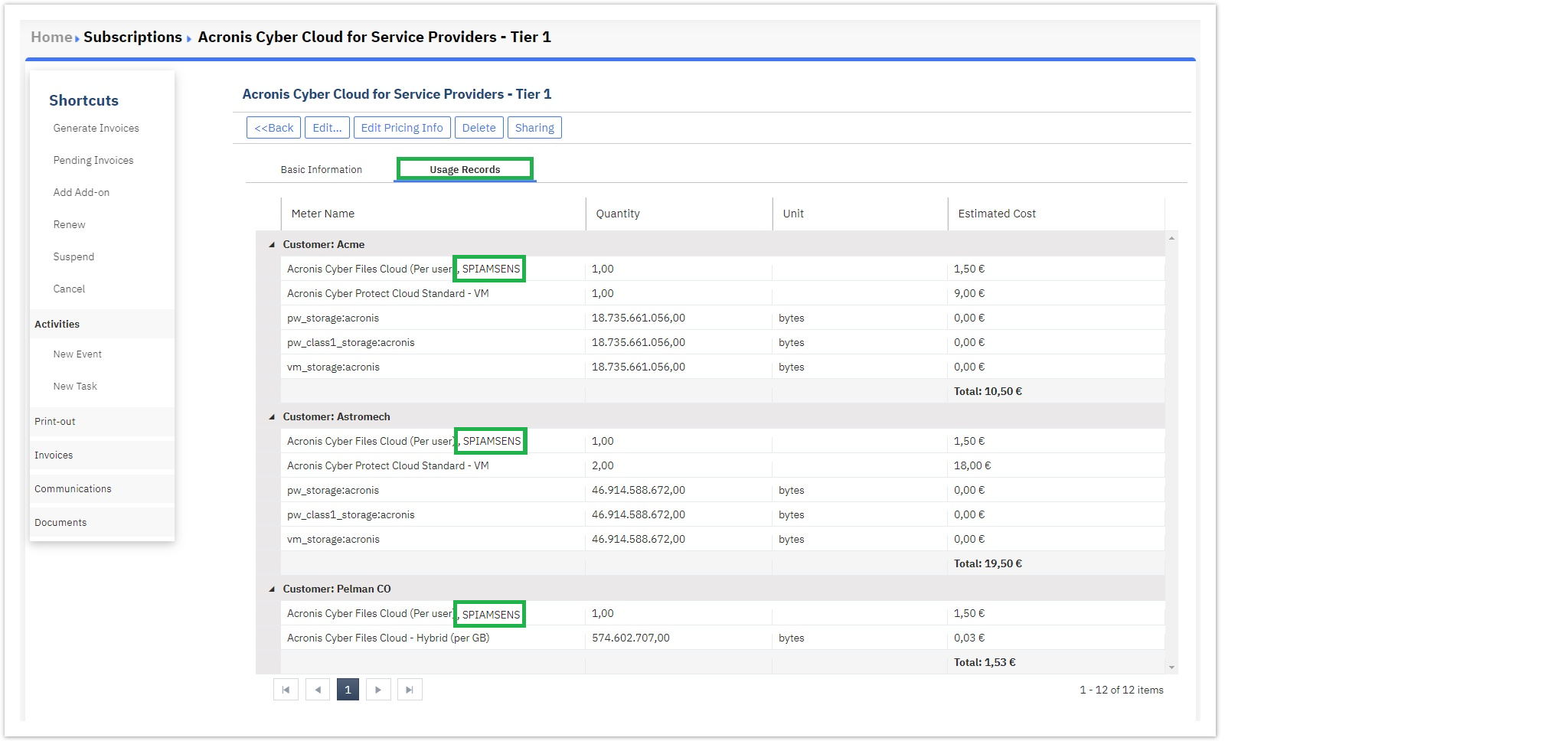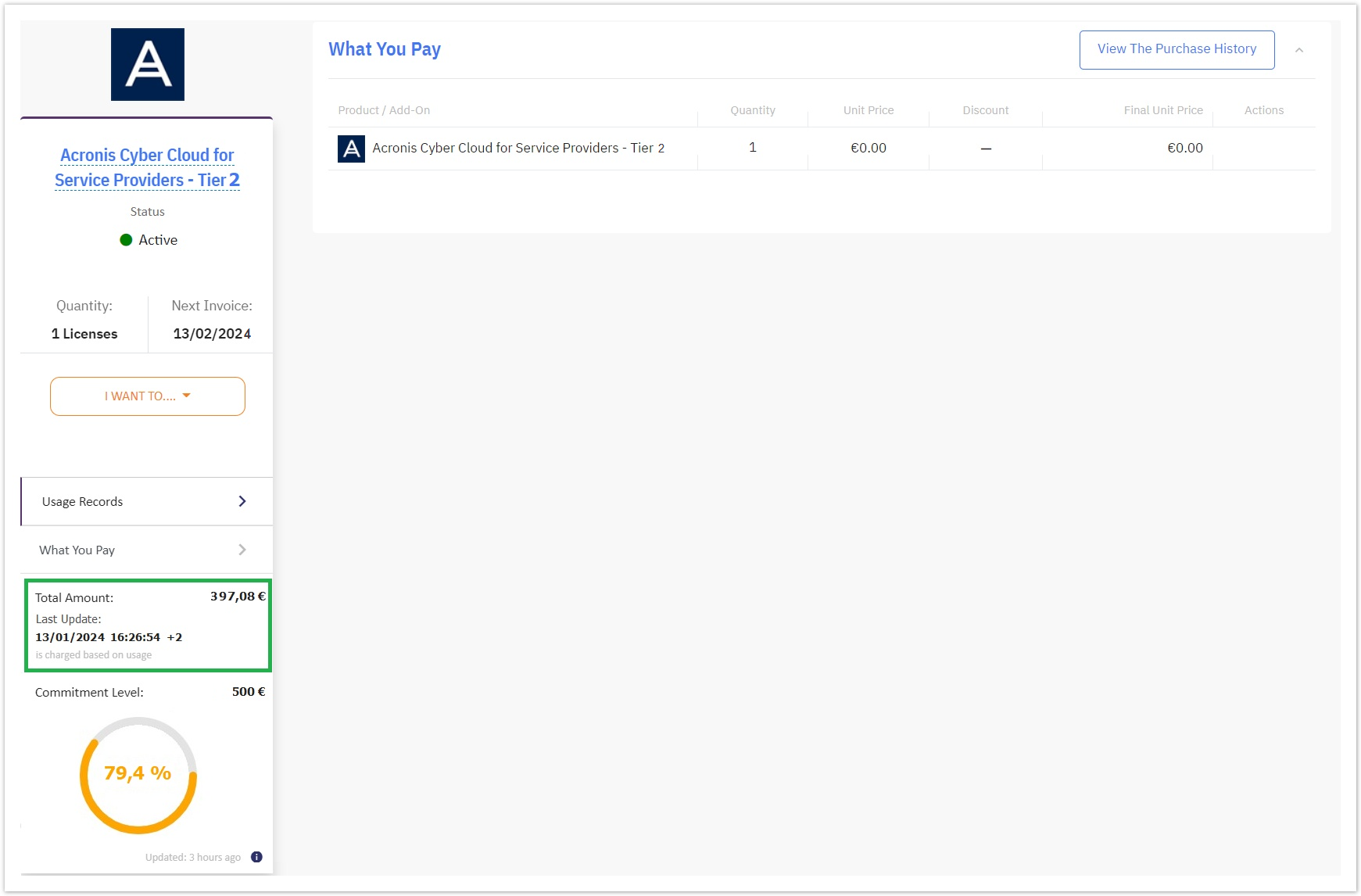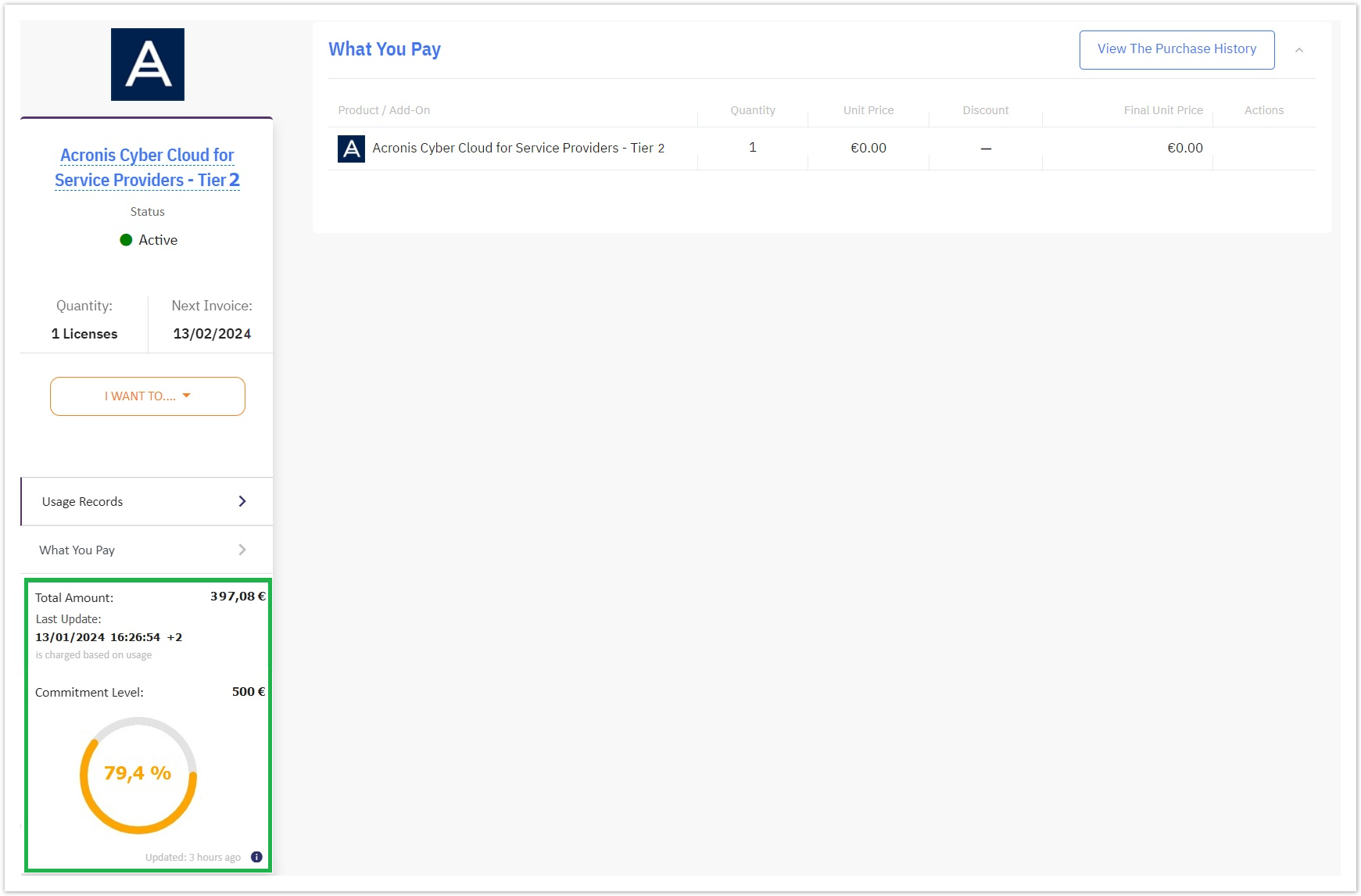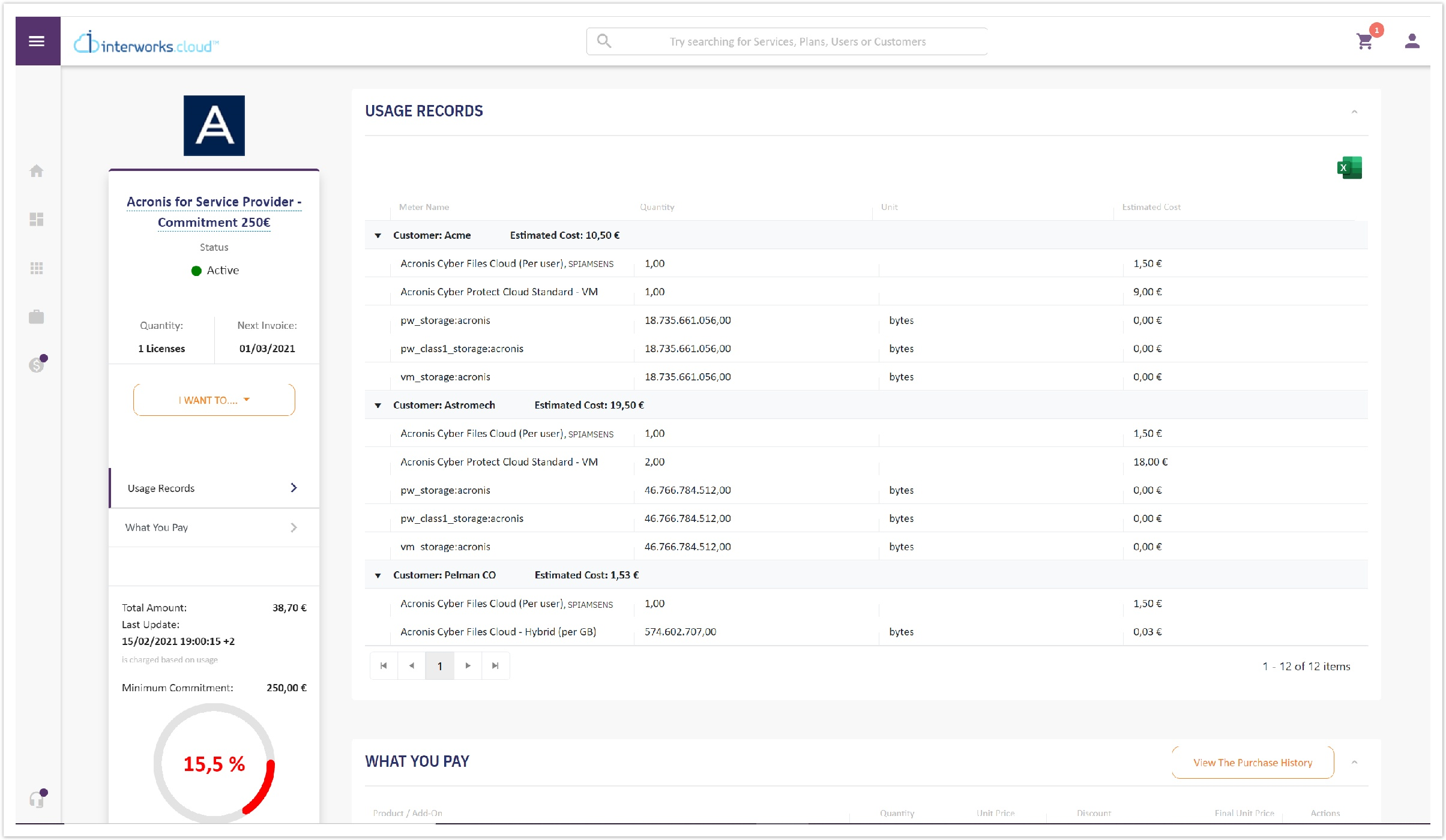Managing an Acronis CSP Contract Subscription
Panagiotis Papanastasiou
Apostolos Karakaxas
There are two approaches that an Acronis CSP Contract subscription can be managed in terms of monitoring its current consumption and usage records. The first one is via the BSS and the second one is via Storefront.
Pay-per-use (PPU) subscriptions need to have an overview of the current consumption as well as the usage records. This way, service providers will be aware of the resources that are currently used and their cost.
Monitoring Current Estimated Consumption & Usage Records
The Total Amount of the current consumption as well as the usage records, can both be monitored via BSS as well as via Storefront. Please note that the Storefront gauge is automatically renewed three times per day.
Current Estimated Consumption in BSS
For checking the current consumption in BSS, you can navigate to the Contract's Subscription overview page, and under the Product section, the "Unit Price" will represent the current consumption.

Usage Records in BSS
For checking the current usage records in BSS, you can navigate to the Contract's Subscription overview page, and under the Usage Records tab, the current billing period analysis of each resource of the contract subscription is displayed on a table list, having the subscription's currency.

Each time the "Usage Records" tab is selected, the usages are updated automatically and the depicted information is the latest available. However, during the update of the usages, only the usage records displayed on this tab are updated, not the subscription amount. This means that there might be differences between the subscription total amount and the sum of the usage amounts displayed on this tab. Also, please note that those usages are not saved in BSS.
The columns of the Usage Records table-list can be used for sorting purposes (ascending or descending order) and are the following four:
- Meter Name: Is the name of the resource followed by its SKU (separated by a comma), as it is provided by Acronis. In case Acronis does not provide us with an SKU, then it will not appear next to the resource name.
Quantity: Is the quantity of the resource, as it is provided by Acronis. This number is displayed rounded to the product’s number of decimals.
- Unit: Is the unit(bytes) of the resource (wherever applicable), as it is provided by Acronis.
- Estimated Cost: Is the total current cost of the specific resource, which is the resource quantity multiplied with its final price. This number is displayed rounded to the product’s number of decimals.
The "Estimated Cost" is the reseller’s cost price, meaning that it is actually the price that the reseller will pay to the distributor (BSS owner).
Pricing rules apply normally to the Estimated Cost, based on the pricing policy of the distributor. This means that when there is an assigned price-list on the subscription, those "Estimated Costs" are defined based on the assigned price-list.
More specifically, the following pricing scenarios are supported:
No price-list on the subscription: The "Estimated Cost" is the sell price as it is provided by Acronis.
Assigned price-list on the subscription: The pricing method defines the "Estimated Cost":
Price-list with discount percent on sell price: The "Estimated Cost" of the resource is the sell price provided by Acronis with the price-list discount applied.
Price-list with markup or margin on cost price: The "Estimated Cost" of the resource is the cost price provided by Acronis with the price-list markup or margin applied.
- Price-list with specific amount: The "Estimated Cost" of the resource is the sell price provided by Acronis.
Usage Records Grouping: Usages in BSS are grouped and displayed, by default, only per the reseller's end-customer. Resellers' end-customer usages are displayed expanded by default. At the bottom of each group, an extra gray line is present which includes the Total "Estimated Cost" for each end-customer. That cost amount is the summation of all the end-customer's used resources, and not only those displayed on a specific page.
Current Estimated Consumption in Storefront
For checking the current consumption in Storefront, the Storefront user can navigate to the Subscription's overview page by clicking on it from the Active Subscriptions list found under the Billing tab. On the left side of the Subscription's overview page, the "Total Amount" of the current consumption is visible along with the date, the hour, and the GMT value of the last update.

Storefront Commitment Indicator Based on Current Estimated Consumption
In Storefront, while looking at the left side of the Subscription's overview page, the Storefront user can also find a visual representation indicator that displays the percentage of the Total Amount of current consumption towards the Commitment Amount/Commitment Level of the particular Contract product.

Therefore, the reseller can clearly understand the percentage of the monthly usages up to that point in time. That results in a more efficient way of managing the Contract usages when a reseller does not wish to exceed his Minimum Commitment.
The indicator is comprised of the numeric percentage indication, along with a completion-circle that both are directly related to the "Total Amount" with respect to the "Commitment Level" amount.
Since the "Commitment Level" amount defines the 100% spot of the indicator, we have the following color indication combinations.
- For percentages ranging from 0% to 59% the color of the indicator is red and the completion circle is drawn relevant to the percentage number.
- For percentages ranging from 60% to 99% the color of the indicator is orange and the completion circle is drawn relevant to the percentage number.
- For the 100% percentage, the color of the indicator is green and the completion circle is fully drawn.
The visual representation indicator is being automatically reset at the end of the monthly billing cycle.
When the Total Amount exceeds the Minimum Commitment/Commitment Level then the indicator will continue to display the green percentage of 100%.
Usage Records in Storefront
For checking the current usage records in Storefront, the Storefront user can navigate to the Subscription's overview page, by clicking on it from the Subscriptions list found under the Billing tab. On the right side of the Subscription's overview page, the "Usage Records" section is visible. In this section of the page, the current billing period analysis of each contract subscription resource is displayed on a table list, having the subscription's currency. The usages are updated each time the Subscription overview page is loaded.

Every element and logic described previously for the BSS Usage Records also applies for the Storefront Usage Records, with the following differences:
Taxation is applied to the Usage Record amounts (Estimated Cost) only when taxes apply to the contract subscription.
The currency culture applies to the amounts displayed on the "Usage Records" section.
The Total "Estimated Cost" for each reseller's end-customer is displayed next to their "Customer" name.
Exporting Usage Records to an Excel File
The Usage Records' table list section contains also an excel icon. By clicking on it, the Storefront user can export and download the usages contained on every page of the "Usage Records" section. Each column displayed on the Subscription's overview page is the exact same found inside the exported excel sheet. Please note that the excel file contains one worksheet. The only differences, in the excel sheet, are that the currency is not displayed next to the amounts, the amounts are not rounded, and an additional column is added to indicate the reseller's end-customer name for each one of the usage records.
The Excel file name consists of the following data: <Subscription's contract name_UsageRecords_Date and time of the last invoice.xls> i.e., "Acronis Cyber Cloud for Service Providers - Tier 1_UsageRecords_09_02_2021_12_00_00.xls".
Excel Sheet Example:

For upgrading or downgrading your Acronis CSP Contract subscriptions, please continue to the "Upgrading/Downgrading Commitment Tier" page.